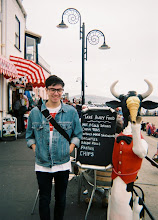As mentioned before I was struck by the direct 1:1 scale that Richard Learoyd employed when constructing and displaying his work. Obviously the resources and funds available to me in creating my own work could not rival Learoyd's, however I could still experiment with scale, something which I have been meaning to do for some time now.
In keeping with my Polaroid approach I wanted to keep the projections rooted in the physical object, though this may seem somewhat contradictory as the projection is an ephemeral creation of light. I did not feel that projecting an image which was a digitally encoded copy of the original would be particularly beneficial to my project, other than to alter the scale of the image and so shied away from using a digital projector and laptop. After having experimented with emulsion lifts and looking particularly at the transparent qualities that the images possessed I felt that this would be a way of projecting them which was truer to my original concept.

I projected the images onto a bare interior wall. This allowed me to capture both the projected image and the texture of the wall, giving another dimension to the images. The limitations of depth of field become apparent in these images again, as the images dry they become fragile and almost brittle, the image becomes distorted and the parts of the transparency not flat to the platen at the base of the projector are not in sharp focus. Colours also suffer somewhat when using this method of projection however I feel that the 'physical' approach to the projection of my images does in some way benefit from these limitations. I also experimented with the idea of distorting the image by the angle of the projection, as can be seen below, the image becomes stretched by projecting it into a corner, whilst one plane can still be seen clearly.

The 'hand-crafted' and 'unique' aesthetic adds rather than detracts, suggesting echoes of the past projected onto the present physical surface. In a way I feel that this could even link to the work of another artist, Rachel Whiteread, whose works such as Ghost (upper) and House (lower), are interior casts of inhabited spaces. The space is coated with plaster and as the plaster casts are pulled away from the original surfaces, detritus and residual traces of previous inhabitants are fixed into it to create an almost 'negative' image of the original. Whiteread's work is also on a scale of 1:1, the casts being created direct from the original space and, in the case of Ghost and House, erected on the site of the initial building. The works deal with filling the uninhabited space, as in her later works in which she cast around books in a library, titled Nameless Library.


I feel that in displaying my work I can utilise the approaches of both Learoyd and Whiteread regarding scale and their individual aspects of the unique image and the residual traces of history held by an object. As a final display for my work a projection of some sort onto a surface with 'history' may be something to consider, this would preferrably be some sort of enclosed interior space rather than an exterior wall.

No comments:
Post a Comment